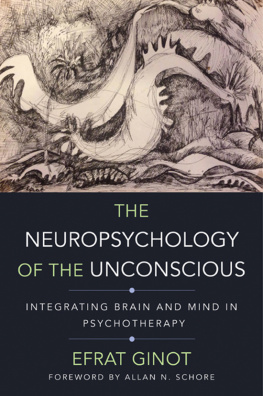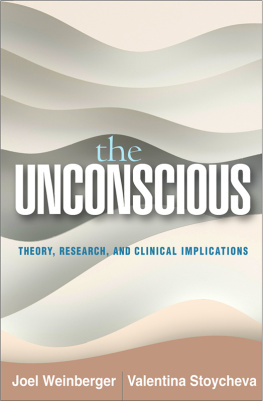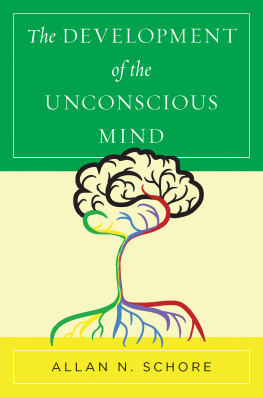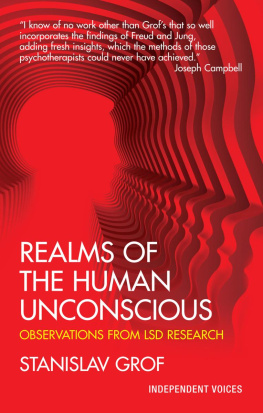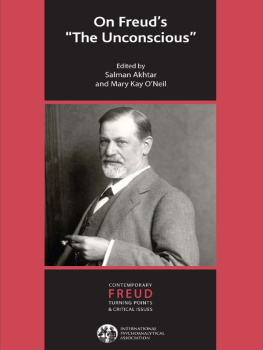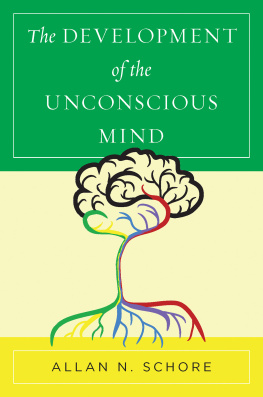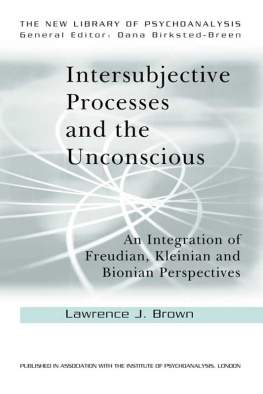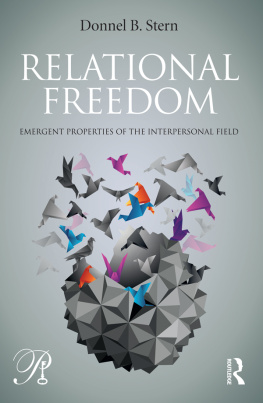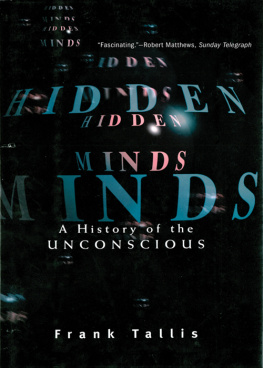
The Neuropsychology
of the Unconscious
Integrating Brain and Mind
in Psychotherapy
Efrat Ginot
FOREWORD BY ALLAN N. SCHORE

W. W. NORTON & COMPANY
New York London
A NORTON PROFESSIONAL BOOK
Copyright 2015 by Efrat Ginot
All rights reserved
First Edition
For information about permission to reproduce
selections from this book, write to Permissions,
W. W. Norton & Company, Inc.,
500 Fifth Avenue, New York, NY 10110
For information about special discounts for bulk
purchases, please contact W. W. Norton Special Sales
at specialsales@wwnorton.com or 800-233-4830
Production manager: Christine Critelli
ISBN: 978-0-393-70901-8
ISBN: 978-0-393-71088-5 (e-book)
W. W. Norton & Company, Inc.
500 Fifth Avenue, New York, N.Y. 10110
www.wwnorton.com
W. W. Norton & Company Ltd.
Castle House, 75/76 Wells Street, London W1T 3QT
To my beloved family: My husband Prem,
my daughters Ariel and Talya Ramchandani
INTRODUCTION
Tackling the Unconscious: Questions with No Easy Answers
E XPLORING THE NEUROPSYCHOLOGY OF UNCONSCIOUS processes is an effort intended to reframe some current ideas of the unconscious. Such efforts, although still in their early stages, may also hold an important key into our psychological functioning and its drawbacks. This book has grown out of more than 30 years of clinical and supervisory experience. Over the years, even as my clinical knowledge and confidence grew, intriguing questions about the psychotherapeutic process have remained. Why are emotional and behavioral difficulties so pernicious, enduring, stubborn, and repetitive even when we gain insight and are determined to change them? I became increasingly curious as to why people continue to engage in behaviors and interactions that cause them misery. Similarly, I wondered why our minds, with all of their magnificent consciousness, sense of agency, and certitude of mastery, cannot make sure we do not reexperience dysregulated self-states or repeat destructive behaviors.
As it became exceedingly clear that it is not easy for most patients to stop and think before acting, adopting new patterns of perceiving feeling and acting, I looked for possible explanations. The interpretations suggesting that a powerful resistance is at play did not offer the reassurance that we truly grasp the underlying reason for such impediments to change. Indeed, as will be discussed in the following chapters, unconscious systems are resistant to change, but not because of defensive reasons or a volitional adherence to old self-object representations; the resistance is built into the machinery of the brain/mind.
It seemed to me then and now that as long as explanations of human behavior did not account for their embeddedness within our bodily properties, our brain/mind processes, something significant was missing. Obviously, as part of the therapeutic process, various psychodynamically based interpretations could be offered in an attempt to address some patients difficulties to pursue more adaptive behaviors. Although such analysis, especially of transferencecountertransference interactions, clearly benefited some patients, for others the difficulties of achieving their therapeutic goals remained, and together we tried to understand the source of stubborn repetitions. Issues regarding the possibility, quality, and range of therapeutic change increasingly appeared to be entwined with implicit processes and internal structures that seemed to have a life of their own.
Over time I realized that the problems involved in lasting changes to ones moods, typical ways of perceiving, feeling, and acting, seem to stem from the tenacious properties of the brain/mind. What has made it even clearer is the often experienced phenomenon of old affects and behaviors, even those thought to have been transformed, reasserting themselves in states of dysregulation. After delving into the neuropsychological literature, it became clear that the answers to these dilemmas (and to others that will be raised in the various chapters) may indeed be found in the way the human brain/mind works. Predisposed to operate in the service of life management in the most energy-saving and efficient ways (Damasio, 2010), and valuing past reinforced learning above all else, unconscious brain/mind systems automatically enact what they already know (Koziol, 2014). As the scope of my research has widened, it has also become evident that the more we learn about our unconscious forces, the better equipped we are to better understand and treat the emotional and behavioral predicaments we encounter in our patients and in ourselves.
Without a doubt, no other development has opened the door to a new understanding of what generates and sustains emotional difficulties and destructive repetitions than the aggregate of neuropsychological findings about unconscious processes. In spite of its neuroscientific underpinnings, this book is not about neuroscience per se. It mostly aims to use neuropsychology to better answer some of the more nagging questions: some relating to the power of unconscious systems to repeat and enact established patterns, others seeking those therapeutic processes that most proficiently enhance enduring changes. The following chapters seek to anchor the understanding of our dynamic lifewith all its complexities and pitfallsin the context of the broad and ever-present processes of the unconscious. As so much of our mental and behavioral functions occur out of awareness and even seem to possess unconscious control processes (Hassin, 2007), the adaptive and the maladaptive functions of the unconscious need to be better explained (Wilson, 2003).
The book, then, strives to expand the theoretical and clinical prism through which we understand the unconscious, its neuropsychological foundations, its pervasive influence, and the resulting implications for clinical practice. Drawing from diverse therapeutic material, affect theory, research in cognitive neuroscience, and other neuropsychological findings, the book presents an expanded picture of unconscious processesone that depicts the unconscious as giving expression to whole patterns of feeling, thinking, and behaving, patterns that are so integrated and entrenched as to make them our personality traits. In particular, it attempts to explore the hidden foundations of the clinical manifestations of repeated self-destructive patterns, resistance to change, and the tendency to experience compromised affect regulation even in the face of seemingly knowing better.
THE CENTRALITY OF THE UNCONSCIOUS
There is no concept as central to psychoanalysis and many other psychotherapeutic approaches as that of the unconscious. Before presenting a new neuropsychological model of unconscious processes, we need to examine why there is a need for an updated understanding based on the latest neuropsychological findings. Following Sigmund Freuds matchless contributions, deciphering the role of unconscious forces in our emotional and interpersonal difficulties has become a cornerstone in clinical work. It is almost inconceivable not to look for unconscious impulses, defenses, conflicts, and motivations as the underlying factors responsible for many patients persistent struggles. Despite the importance we assign to the unconscious, some of the prevalent assumptions about its attributes are being challenged by fast-growing neuropsychological data.
For instance, the terms repression and more recently dissociation have come to most commonly describe the defensive functions of the dynamic unconscious. Painful memories, traumatic experiences, intolerable affects, and conflictsor other experiences that do not fit the conscious sense of selfare rejected from consciousness and relegated to the unconscious domain. In clinical practice, we often use the concepts of repression and dissociation with the confidence that they actually convey a psychological reality about how our minds operate. We assume that when we do not recall events from our childhood we forget them for a reason and that we tend to disavow and reject traumatic and painful experiences that are rejected by our conscious ideas of who we are.
Next page
